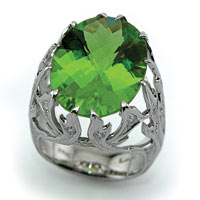PERIDOT - The Sparkle of the Summer Grass
This gemstone is born in fiery lava. Peridot forms where certain types of lava cool slowly
in the ground before they are erupted on to the surface. The crystals of gem
peridot grow in the slowly cooling magma melt before it is erupted onto the
surface. The type of volcanic rock that peridot grows in is called basalt. That is why it is known as the
volcanic gem. Once the lava comes to the surface it cools quickly. Small crystals of Peridot are often found in the rocks created by volcanoes
and can even be found in some meteors which fall to earth. Peridot is the gem form of the
mineral olivine. Because the iron which creates the color is an integral part of its
structure, the gem is found only in shades of green, ranging from a summery light
yellowish green to a 7-up bottle green to a brown green. The purer green the color of
Peridot the higher the value. Any tinge of brown greatly diminishes the price as well as
any visible flaws. Very large peridot gems (50 carats+) are presently available on the market,
but are rare.
This gemstone has the good gem properties of reasonable hardness (7), moderate refractive
index, durability and brilliance. It is also available at a reasonable price. Care should
be taken to protect it from scratches, sharp blows, household chemicals and extreme
temperature changes. Do not use a home ultrasonic machine for cleaning this gem. Peridot is the birthstone for the month of August.
Peridot has been mined in Egypt on an island called Zeberget for three thousand years. The Egyptians fashioned Peridot gems out of these stones as early as the 1500 BC. The Romans called Peridot "evening emerald," since its green color did not darken at night but was still visible by lamplight. However, little gem material is mined there now.
Peridots are also perhpas the only gemstone with examples that have come from outer space. There is a type of stony-iron meteorite known as a pallasite, which is famed for containing areas of yellowish green peridot. Since the earliest description by Peter Simon Pallas in the 18th century, reference has been made to the gem-like nature of these meteroite "inclusions." Not until the early 20th century, however, was there any record of a faceted peridot gem which was cut from such a meteorite. Still to this day only a handful of stones been available for gemological examination. Study of these peridots faceted from pallasites reveals they possess gem properties similar to their terrestrial counterparts.
Today, much of the world’s supply of Peridot is mined in the US by Native Americans on the San Carlos Reservation in Arizona. Peridot occurs there in an old flow of basalt lava and is dug by hand by the tribal members. Outsiders and mechanized equipment are not allowed in the work area. Fine large peridots are also found in Myanmar (formerly Burma) and Peridot is also mined in Tanzania, China and Sri Lanka. In 1994, an exciting new deposit of Peridot was discovered in Pakistan, and these stones are among the finest ever seen. The new mine is located 15,000 feet above sea level in the Nanga Parbat region in the far west of the Himalaya Mountains in the Pakistanian part of Kashmir. Beautiful large crystals of peridot were found, some that cut magnificent large gemstones. One stone was more than 300 carats! This new discovery, combined with fashion's passion for lime green, has revived interest in Peridot and increased the currently popularity of this gemstone. Peridot gems of less than 5 carats can usually be obtained at reasonable prices, considerably less than $100 per carat.
Although peridot is treasured in Hawaii as the goddess Pele's tears, almost all of the peridot sold in Hawaii today is from Arizona, even though some very small peridot crystals are produced from lava which flowed out of Hawaii's volcanoes. The Island of Oahu even has a beach where the sand is green and made of peridot (olivine) grains, but these sand grains are much too small to cut into gemstones.

Peridot Ring